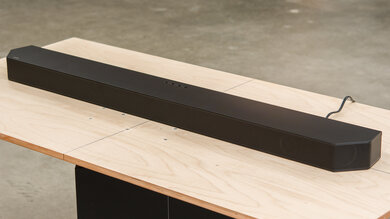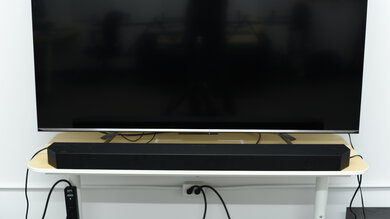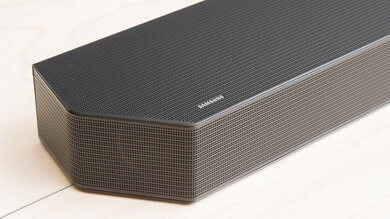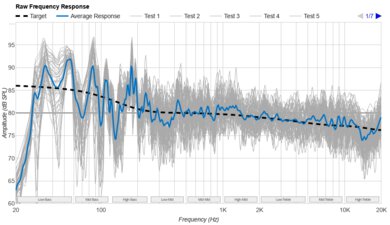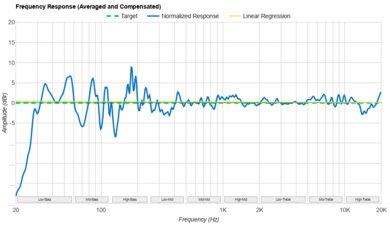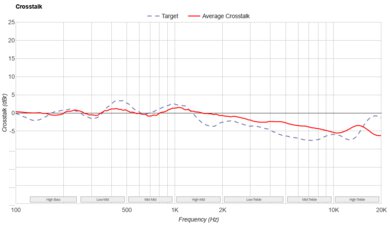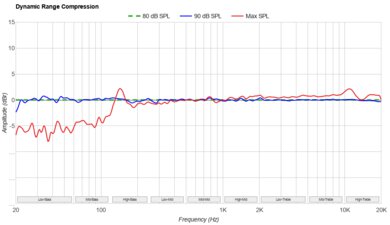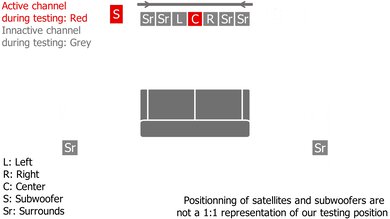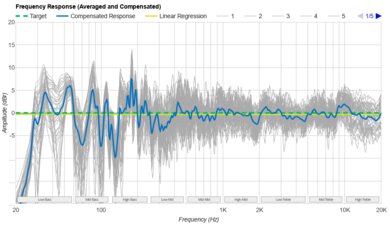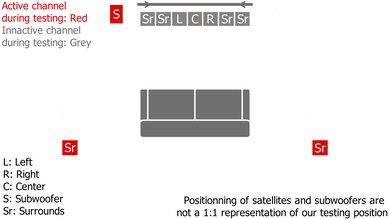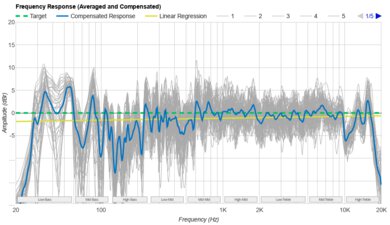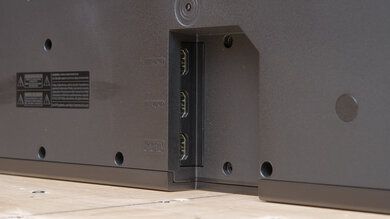The Bose TV Speaker is a simple plug-and-play soundbar released in 2020. Designed as a step up from your TV speakers, its small, compact design makes it ideal for those who don't have a lot of space in their setup, and its 2.0 design makes it ideal for enhancing stereo content, which includes most music and TV shows. Naturally, it doesn't come with as many features as Bose's more premium offerings, like the Bose Smart Soundbar 900, and it doesn't sound quite as immersive.
Our Verdict
The Bose TV Speaker is acceptable for mixed usage. It's a 2.0 bar that lacks the extra bells and whistles of more premium offerings, so it's better suited for users who just want to improve stereo content like music and TV shows. Its default sound is quite balanced, meaning that voices and lead instruments are clear in the mix. You won't find a lot of customization tools, though, and it's not ideal for listening to multi-channel content.
- Dialogue enhancement feature available.
- Bluetooth-compatible.
- Bass adjustment feature available.
- Doesn't support Atmos.
- No EQ or room correction feature.
- Compression artifacts at max volume.
The Bose TV Speaker is fair for dialogue-heavy TV shows and podcasts. It's a 2.0 bar, so it lacks a discrete center channel, but thanks to its balanced mids, you don't have any trouble following the action in your favorite shows. Voices are clear and detailed, and a dialogue enhancement tool is on hand. Since it's Bluetooth-compatible, you can stream podcasts from your phone to the bar.
- Dialogue enhancement feature available.
- Bluetooth-compatible.
- Compression artifacts at max volume.
- No auto-volume mode.
The Bose TV Speaker is alright for music. Its default frequency response is quite balanced, especially in the mids, where most voices and lead instruments reproduce. As a result, it's suitable for most music genres, and there's even a little extra boom and warmth to mixes. However, like most small, standalone bars, it has difficulty reproducing deep low-bass rumble, so you won't feel your chair move along with bass-heavy genres like EDM. You can add a subwoofer to improve its bass reproduction, but it's a separate add-on.
- Bluetooth-compatible.
- Bass adjustment feature available.
- No EQ or room correction feature.
- Compression artifacts at max volume.
The Bose TV Speaker isn't ideal for movies. Dialogue sounds clear, but without a sub, it struggles to bring the deep rumble in the bass that brings a cinematic feel to action-packed movies. It's a 2.0 setup, too, so multi-channel content like Dolby Digital downmixes into stereo. There's no support for more immersive formats, like Dolby Atmos, which is disappointing if you watch a lot of movies on streaming platforms.
- Bass adjustment feature available.
- Doesn't support Atmos.
- No EQ or room correction feature.
- Compression artifacts at max volume.
Changelog
-
Updated Nov 05, 2024:
The Surround 5.1 and Height (Atmos) boxes have been updated to mention the Bose Smart Soundbar.
- Updated Oct 11, 2024: This review has been updated to mention the Roku Streambar SE in the Wireless Playback section.
- Updated Jun 04, 2024: Updated text in Stereo Dynamics, Audio Latency: ARC, and Audio Latency: Optical boxes with new methodology from TBU 1.3. Some updates to the usages as well.
- Updated Jun 03, 2024: We've converted this review to Test Bench Update 1.3. If applicable, we've retested stereo sound based on the manufacturer's recommendations. Additionally, we've expanded our audio latency tests to the following boxes: Audio Latency: ARC, Audio Latency: HDMI In, and Audio Latency: Optical. You can see the full changelog here.
Check Price
Differences Between Sizes And Variants
The Bose TV Speaker soundbar comes in 'Black', and you can see the label for the model we tested here.
If you encounter another version of this soundbar, let us know in the forums, and we'll update our review.
Popular Soundbar Comparisons
The Bose TV Speaker is a very compact 2.0 soundbar designed for TVs and TV-centric content. While it's pretty bare-bones in features, it delivers decent bass with smooth and neutral mids right out of the box, which is better suited for dialogue-centric content. It's also fairly easy to set up since it only has a couple of inputs, so you can watch your favorite game shows or soap operas without too much delay. You can expand this setup with one of Bose's Bass Modules, which is nice. However, this soundbar doesn't get very loud, so it may not be ideal for large or crowded rooms.
If you're looking for more soundbars, check out our recommendations for the best small soundbars, the best soundbars for dialogue, and the best soundbars under $300.
Depending on your listening habits, you may prefer the Bose TV Speaker or the Sonos Ray. They're both budget-friendly 2.0 setups that are best with music and dialogue-focused TV shows. However, the Bose can reproduce a more extended low-bass, making you feel more rumble in the mix. Unlike the Sonos, it supports HDMI connectivity, too. However, the Sonos comes with more sound enhancement features, such as room correction, and it lets you connect to the Sonos ecosystem through its Sonos S2 app. There's even DTS support, which the Bose lacks.
The Bose Solo Soundbar Series II and the Bose TV Speaker are similar 2.0 soundbars. The TV Speaker is better overall, having a couple of extra features. It's better built and has an HDMI ARC port, so it supports HDMI CEC to let you control the bar's basic features with your TV remote. Its stereo soundstage is better, too. These features may not be worth the value for some, so the Series II is a more affordable alternative.
The Sonos Beam is a better soundbar than the Bose TV Speaker. The Sonos is a 3.0 setup with a better surround performance. It comes with more sound enhancement features, it can get loud enough for a large room, and you can stream music wirelessly to it using Wi-Fi or Apple AirPlay. It also has a companion app that can control all the bar's features. However, the Bose is a 2.0 setup that lets you use Bluetooth to play audio from your phone. The Bose also has an auto-off power-saving feature.
The Bose TV Speaker is a better 2.0 setup for dialogue and TV shows than the Bose Solo 5. The TV Speaker feels better built, and its sound profile is more neutral. The TV Speaker also has an HDMI ARC port. However, while the Solo 5 doesn't get as loud as the TV Speaker, it can reach max volume with less thumping and compression artifacts.
Test Results



